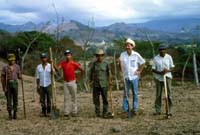Organization of the Work:
|
To achieve the most efficiency in production, increase quality and minimize the time required for training we have organized the construction workers into teams specialized in particular aspects of the work. For the next phase of work we have selected 6 areas of expertise: 1) lumber production, 2) tile production, 3) masonry & stone work, 4) adobe, 5) Rough Carpentry, 6) Finish Carpentry.
|
 Huck Rorick and construction crew.
Huck Rorick and construction crew.
click on the image for a larger version.
|
1) Lumber Production: Cutting, chain sawing boards, hauling, circular saw ripping to width, stacking/drying, etc. This team should have 4 workers: Chain saw operator & helper, circular (Skil) saw operator & assistant.
2) Tile Production: Gathering fire wood, clay materials, mixing clay, making tiles, firing, hauling. 6 workers.
3) Stone Workers: Quarry & haul stone, dig & lay foundation, lay floors, mortar, set roof tiles. (Note: these could be further divided between foundation, floors, and roof). 6 workers: 2 to place stone
in walls, 4 to quarry and haul. 2 to place floor stone (one placing, one mortaring and washing), 4 to haul and place sand, haul stone.
4) Adobe: gather stone and soil, mix, place in walls, plaster walls, whitewash. 6 workers.
5) Rough Carpentry: transport lumber to site, frame walls & roof. 3 workers.
6) Finish Carpentry: build doors and windows. Install doors, windows, and trim. (Rough and finish can be combined into one team.) 2-3 workers.
In addition to these teams a supervisor is needed. This person may be a member of one of the other teams and is responsible for knowing the building design, doing layout, and coordinating the work.
There may also be a crew of unskilled helpers who can assist with hauling, digging, etc. These may also be supplemented by non-construction workers. For example, during construction of the adobe walls the women and children of the cooperative pitched in greatly helping the work.
Since the coop in San Dionisio could only allocate 10 workers, we made do with 4 teams: 1) lumber production, 2) tile production, 3) Masonry & adobe, 4) Carpentry. There was some overlap between the teams.
Each of the aspects of the work takes a different amount of time to complete. This means that each team can complete its work on a different number of houses per year. For example, the lumber production team of 4 men can produce wood for 48 houses/year. But the tile production team can only produce tile for 12-24 houses/year. This means that for each team of lumber producers there must be 2-4 teams of tile producers. To keep a balanced and efficient work flow there must be the right number of teams and workers in each of the specialized areas.

· home · projects · bulletin board · links · who are we · contact ·
|

